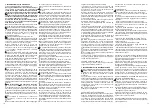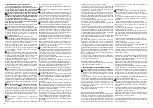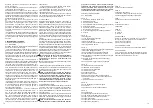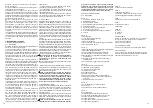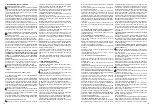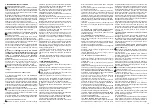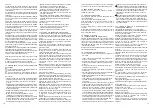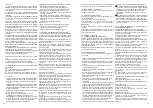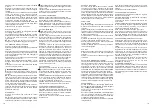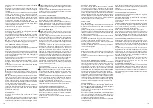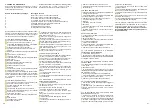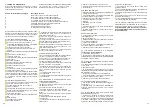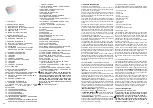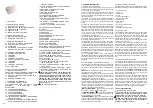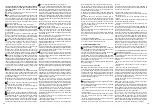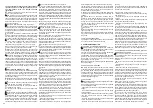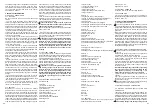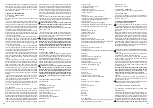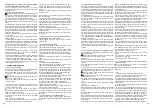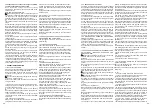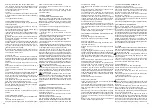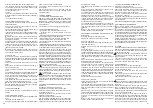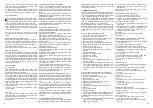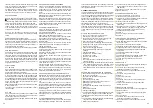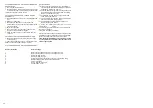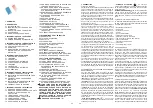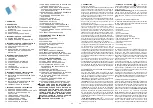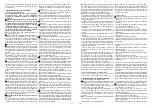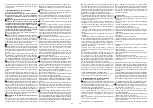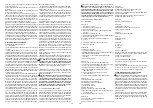
25
24
The manufacturer will not be held responsible for
injuries to persons or damage to property due to
non-compliance with the aforementioned
instructions.
Before using the machine, make sure that each
part is in the correct position.
The machine can only be used by personnel who
have received appropriate training, who have proven
their skills and who have been expressly assigned to
use it. To avoid unauthorised use, keep the machine in
a place that denies access to unauthorised personnel
when not being used.
Minors are prohibited from using the machine.
Do not operate this machine for any other purpose
except for the use for which it was specifically designed.
Evaluate the type of building where it will be utilised
and rigorously comply with the current safety regulations
and conditions.
Do not use the machine in places without adequate
lighting, in explosive environments, when harmful dirt
is present (dust, gas, etc.), on roads or public passage
ways and in outdoor environments in general.
The machine operating temperature range is +4°C
to + 35°C; when not being used, store the machine in
a dry and non-corrosive environment within a
temperature range of b 10°C and + 50°C.
When using the machine under any condition the
humidity must range between 30% and 95%.
Never use or vacuum liquids, gases, dry dust, acids
and solvents (e.g. paint thinners, acetone, etc.), even
if diluted, inflammables or explosives (e.g. petrol, fuel
oil, etc.); never vacuum flaming or incandescent objects.
Do not use the machine on slopes or ramps steeper
than 10%; for small slopes, do not use the machine
sideways, always handle it with caution and never move
backwards. When transporting the machine on steeper
ramps or slopes, be very careful to avoid tipping and/or
uncontrolled accelerations. Use only the lowest speed!
The machine can be handled on ramps and/or steps
only with the brush head and squeegee lifted off the
ground.
Never park the machine on a slope.
The machine should never be left unattended with
the motors running; it can be left unattended only after
turning off the motors, ensuring that it wont make any
accidental movements and disconnecting it from the
electric power supply.
Make sure there are no other persons, and children
in particular, in the area where the machine is being
used.
Do not use the machine to transport persons/things
or to tow objects. Do not tow the machine.
Do not use the machine as a support surface for
any weight for any reason.
Do not block the ventilation and heat dispersion
openings.
Do not remove, modify or by-pass the safety devices.
Always use individual safety devices to ensure
operator safety: aprons or safety overalls, non-slip and
waterproof shoes, rubber gloves, goggles and
earphones, and masks to protect the respiratory tract.
Before starting to work, remove necklaces, watches,
ties and other objects that may cause serious injuries.
Do not insert hands between moving parts.
Do not use detergents that differ from those required
and follow the instructions indicated on the relative
safety sheets. Detergents should be stored in a place
that is inaccessible to children. In case of contact with
the eyes, rinse immediately with copious amounts of
water and, if swallowed, immediately consult a physician.
Make sure that the battery charger power sockets are
connected to an efficient earthing system and that they
are protected by magnetothermal and differential circuit-
breakers.
If you are going to equip the machine with dry (gel)
batteries, be sure the battery power indicator on the
control panel, has been set properly. Check this
procedure with your dealer.
Follow the battery manufacturers instructions and
comply with legal provisions. The batteries should
always be clean and dry to avoid surface leakage
currents. Protect the batteries against impurities, such
as metallic dust.
Do not place tools on top of the batteries: they may
cause a short-circuit or an explosion.
When using battery acid, rigorously respect the
relative safety instructions. In the presence of particularly
strong magnetic fields, evaluate the possible effect on
electronic control devices.
Never spray water on the machine to clean it.
Recovered fluids contain detergents, disinfectants,
water, as well as organic and inorganic material collected
during work operations: dispose of them in accordance
with current legal provisions.
If the machine malfunctions and/or operates
inefficiently, turn it off immediately (disconnecting it from
the electric power supply or from the batteries) and do
not tamper with it.
Contact one of the manufacturers technical service
centres.
All maintenance or accessory replacement operations
must be carried out in environments with adequate
lighting and only after having disconnected the machine
from the electric power supply by detaching the battery
connector.
All work on the electrical system and all maintenance
and repair operations (especially those not explicitly
described in this manual) should be carried out only by
authorised service centres or by specialised technical
personnel who are experts in the sector and in the
pertinent safety regulations.
The machine owner can only use original
accessories and spare parts supplied exclusively by
the manufacturer since such parts are the only ones
that guarantee that the equipment will operate safely
without any problems. Do not use parts disassembled
from other machines or other kits as spare parts.
If the machine will no longer be used, remove the
batteries and dispose of them in accordance with the
eco-compatibility regulations as set forth in European
standard 91/157/EEC or deposit them in an authorised
collection centre.
To dispose of the machine, comply with the current
laws where it is used:
- disconnect the machine from the mains and clean it
after emptying any liquids;
- separate the machine into groups of homogeneous
materials (plastics in accordance with the recycling
symbol, metals, rubber, packing). For parts containing
different materials, contact the competent authorities;
Each homogeneous group must be disposed of in
accordance with recycling laws.
In addition, it is recommended to eliminate those parts
of the machine that may be dangerous, especially for
children.
Before each use, check the machine and, in
particular, check that the battery charging cable and
the connector are in good condition and safe for use.
If they are not in perfect condition, do not use the
machine for any reason until an authorised specialist
repairs the defective parts.
If foam or liquid is noted, immediately turn off the
suction motor.
Do not use the machine on textile flooring, such as
rugs, carpeting, etc.
Wax, foaming detergents or dispersions along the hoses
may cause serious problems for the machine or clog
the hoses.
3.2 NOISE AND VIBRATIONS
The machine is designed for indoor use and therefore
is not subject to the reference directives.
4. HANDLING INFORMATION
4.1 PACKING LIFTING AND TRANSPORT
During all lifting or transport operations, make sure
that the packed machine is securely anchored to prevent
it from tipping over or falling accidentally.
Transport vehicle loading and unloading operations
must be carried out with adequate lighting.
The packed machine must be handled using adequate
devices, making sure not to damage/strike any part of
the packing, not to tip it over and to be very careful
when placing it on the ground.
All these instructions also apply to the batteries and
the battery charger.
4.2 CHECKS UPON DELIVERY
When the goods are delivered (machine, battery
or battery charger) by the transporter, carefully check
the condition of the packing and its contents. If the
contents have been damaged, notify the transporter
and reserve the right, in writing (select the word reserve
on the document), to submit a claim for compensation
before accepting the goods.
4.3 UNPACKING
Wear safety clothing and use adequate tools to limit
the risks of accidents.
Carry out the following steps if the machine is packed
with a cardboard housing:
- Use scissors or clippers to cut and eliminate the plastic
straps.
- Slip off the cardboard housing from the top of the
packed machine.
- Remove the envelops inside and check their contents
(use and maintenance manual, battery charger
connector)
- Remove the metallic brackets or plastic straps that
secure the machine to the pallet.
- Release the brushes and the squeegee from the
packing.
- Take the machine off the pallet (pushing it backward)
by using an inclined surface that is solidly attached to
the floor and to the pallet.
If the machine is packed in a wooden crate:
- Detach all the wooden sides from the pallet, starting
from the top one.
- Remove the protective film wrapped around the
machine.
- Remove the metallic brackets or plastic straps that
secure the machine to the pallet.
- Release the brushes and the squeegee from the
packing.
- Take the machine off the pallet (pushing it backward)
by using an inclined surface that is solidly attached to
the floor and to the pallet.
Take the same precautions and follow the same
instructions to remove the optional battery charger from
the packing (holding the special handles to extract it
from the top of the packing) and the optional battery.
After moving the machine away from all the packing,
start mounting the accessories and the batteries as per
the instructions provided in the specific section.
Keep all the pieces of the packing since they might be
useful in the future to protect the machine and the
accessories during transport to another location or to
authorised service centres. If not, the packing can be
disposed in accordance with current disposal laws.
4.4 LIFTING AND TRANSPORT: MACHINE, BATTERY
AND BATTERY CHARGER
Never use a forklift truck to lift the machine. There
are no places on the frame that can be used to lift the
machine directly.
Before preparing the packing and transporting the
machine:
- Empty the recovery tank and the detergent solution
tank.
- Disassemble the squeegee and the brushes or
scrapers.
- Disconnect and remove the batteries.
Place the machine on the original pallet (or an equivalent
one that can bear the weight and is big enough for the
machines overall dimensions) using an inclined surface.
Solidly anchor the machine and the squeegee to the
pallet using metallic brackets or other elements that
can bear the weight of the parts.
Lift the pallet with the machine and load it on the
transport vehicle.
Secure the machine and the pallet using ropes
connected to the transport vehicle.
As an alternative, when using private transport vehicles,
use inclined ramps to push the machine without the
pallet, making sure to protect all parts and the machine
itself against violent impacts, humidity, vibrations and
accidental movements during transport.
To lift or insert the battery (into the machine
compartment), use only suitable personnel and
equipment (cables, eyehooks, etc.) for the operation
and to bear the weight of the loads involved. When
transporting, take the same precautions and follow the
same instructions provided for the machine together
with those in the special manufacturers manual.
Summary of Contents for KF75B
Page 4: ...4 5 D C E F...
Page 5: ...4 5 D C E F...
Page 6: ...7 G H I L M 6...
Page 7: ...7 G H I L M 6...

